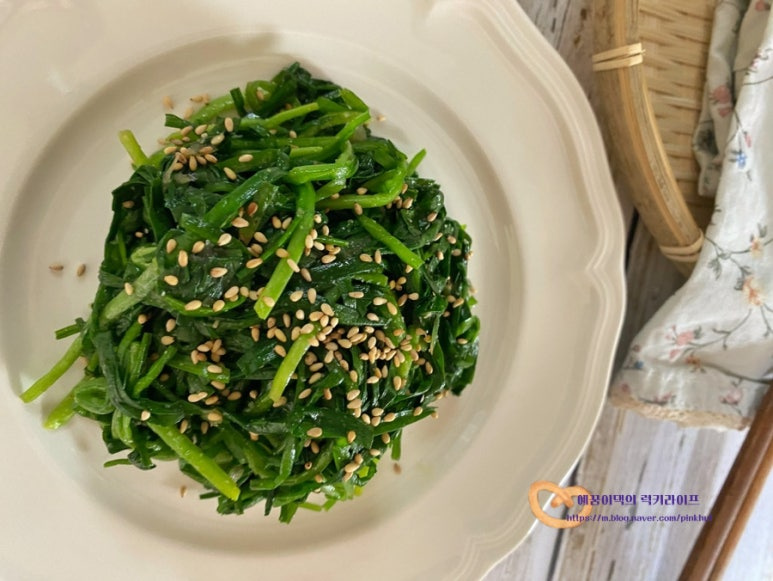Seasoned Chives (Buchu Namul Muchim): A Flavorful Alternative for Festive Three-Color Side Dishes
Recipe for Buchu Namul Muchim, a great substitute for the traditional three-color side dishes served during Korean holidays. Includes tips on blanching chives and making chive dishes.

Today, I’m sharing how to make Buchu Namul Muchim, a staple side dish for Korean holidays. The ‘three-color’ side dishes (Samsek Namul) traditionally served during Chuseok represent black (gosari/fernbrake), white (doraji/bellflower root, radish), and green (spinach, minari/water parsley). While green vegetables are visually appealing and easy to prepare, their prices often soar during the holiday season. I was surprised to see spinach costing 9,000 won for just 200g! However, you wouldn’t want to skip the green component of the Samsek Namul entirely. That’s why I’ve chosen ‘Buchu Namul Muchim’ today, offering a delicious green side dish at a reasonable price. Unlike the typical spicy and fresh Buchu Muchim (often made with raw chives like a kimchi variation), this recipe involves lightly blanching the chives and seasoning them, similar to how you’d prepare spinach namul. This method results in a tender, mild, and incredibly versatile dish that’s perfect for festive occasions and everyday meals alike. The key to perfect Buchu Namul is the blanching process: overcooking will make the chives tough. The blanching time should be kept very short – no more than 10 seconds! Immediately after blanching, rinse the chives under cold water to stop the cooking and preserve their tender texture. Follow these steps, and you’ll achieve a 100% success rate in making delicious Buchu Namul!
Main Ingredients- 150g fresh chives
- 1/2 Tbsp coarse salt (for blanching)
- Water (for blanching)
Seasoning Ingredients- 1/2 Tbsp minced garlic
- 2/3 Tbsp tuna extract (or soy sauce for soup, adjust to taste)
- 1 Tbsp sesame oil
- 1 Tbsp sesame seeds (ground)
- A pinch of whole sesame seeds (for garnish)
- 1/2 Tbsp minced garlic
- 2/3 Tbsp tuna extract (or soy sauce for soup, adjust to taste)
- 1 Tbsp sesame oil
- 1 Tbsp sesame seeds (ground)
- A pinch of whole sesame seeds (for garnish)
Cooking Instructions
Step 1
First, prepare 150g of fresh chives. Commercially sold chives are usually well-trimmed, making them easy to wash. If you find any wilted or yellowed leaves, remove them for a cleaner appearance. Wash the chives thoroughly under running water to ensure all dirt and debris are removed. Using fresh, vibrant chives is crucial for the best flavor.

Step 2
After washing, gently pat the chives dry or let them drain briefly in a colander. Then, arrange them neatly on a cutting board. Trim off any dirty or bruised ends for a neat presentation.

Step 3
Now, cut the chives into bite-sized pieces. Aim for about 4-5 cm in length, which is roughly four cuts per bunch. Cutting them too short can cause them to break apart during mixing, so maintain a reasonable length.

Step 4
Fill a pot with plenty of water and bring it to a rolling boil over high heat. Once the water is boiling vigorously, add 1/2 tablespoon of coarse salt. Adding salt to the blanching water helps to enhance the vibrant green color of the vegetables, making them look even more appealing.

Step 5
Carefully add the prepared chives to the boiling water and blanch for just 10 seconds. This short duration might seem brief, but chives cook very quickly, and 10 seconds is sufficient. Over-blanching will result in tough, limp chives, so precision is key.

Step 6
The 10-second blanching time means you need to be ready to remove the chives almost immediately after submerging them. The goal is to blanch them very briefly – just a quick dip – to prevent them from becoming tough. Keep an eye on the timer and quickly scoop them out before the 10 seconds are up. Precise timing is the secret to success!

Step 7
Immediately after blanching, rinse the chives under cold running water to stop the cooking process and cool them down. Gently swish them in the cold water to help retain their crispness and tender texture. Once cooled, gently squeeze out excess water. Be careful not to squeeze too hard, as this can crush the chives.

Step 8
Place the drained chives in a mixing bowl. Gently loosen any clumps with your fingers to ensure the seasoning will be evenly distributed. Now, it’s time to add the seasonings: 1/2 tablespoon of minced garlic, 2/3 tablespoon of tuna extract (or soy sauce for soup), 1 tablespoon of sesame oil, and 1 tablespoon of ground sesame seeds for a nutty aroma. Be mindful not to exceed 2/3 tablespoon of tuna extract to avoid a salty taste; it’s always best to adjust the seasoning to your preference at the end.

Step 9
With all the seasonings added, gently toss and mix the chives with your hands. Be delicate to avoid mashing the chives, ensuring the seasoning coats every strand evenly. This mixing process allows the fragrant chives and the savory seasoning to meld beautifully, creating a delightful harmony of flavors. The aroma of sesame oil will be wonderfully inviting!

Step 10
Finally, arrange the beautifully seasoned Buchu Namul Muchim on a serving plate. Sprinkle a pinch of whole sesame seeds on top for an extra touch of nutty flavor and visual appeal. And there you have it – a delightful and festive Chuseok holiday side dish, Buchu Namul Muchim, is ready! This dish is elegant enough for guests or as part of your holiday table.



